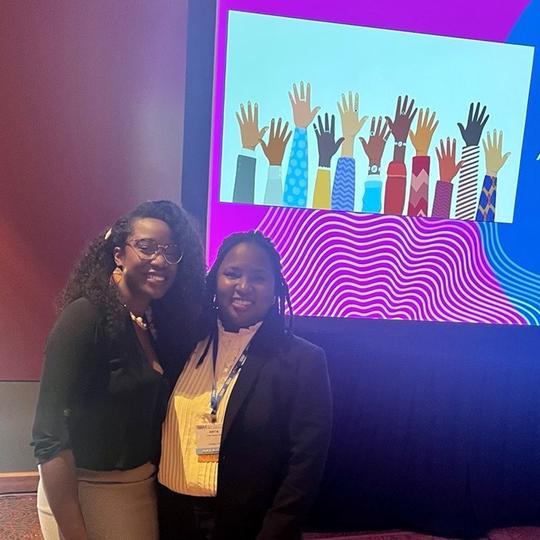FARE Research Projects at AAAAI 2023
Learn about studies presented by FARE staff members at the annual meeting of the American Academy of Allergy, Asthma & Immunology in San Antonio, TX, held Feb. 24-27, 2023.
Understanding food insecurity, food allergy management and related psychosocial burden—possible determinants of food allergy disparities in a national community-based survey

Anita Roach, FARE Vice President of Health Equity and Community Engagement, joined FARE staff and investigators from FARE Clinical Network’s Midwest Allergy Research Initiative and Northwestern University's Center for Food Allergy and Asthma Research (CFAAR) to report how food insecurity impacts the burdens of living with food allergy and challenges of managing the disease.
A FARE Community Access Program survey collected insights from nearly 5,600 individuals, including adults with food allergy, parents and caregivers of food-allergic children, and partners and spouses of food-allergic adults. The survey was completed in English or Spanish, and two-thirds of of those surveyed identified as non-White. Seventy (70) percent of respondents screened at risk for food insecurity, having answered “often true” or “sometimes true” to one or both of the following validated questions:
- “Within the past 12 months we worried whether our food would run out before we got money to buy more.”
- “Within the past 12 months the food we bought just didn’t last and we didn’t have money to get more.”
Even accounting for differences in race/ethnicity and household income, survey participants at risk for food insecurity were more likely to report anxiety and depression symptoms as well as food allergy-related burdens including anxiety, anger, loneliness, fear of eating, and bullying. They were more likely to believe that food allergen exposure would be fatal, but were less likely to have an epinephrine auto-injector immediately accessible. All these differences were statistically significant. These results indicate that food allergy patients and caregivers at risk for food insecurity could benefit from food insecurity screening and improved supports for mental health and disease management.
Practical Applications to Address Health Disparities and Inequities in the Clinical Setting: A Hands-On, Problem-Based Learning (PBL) Workshop

Ms. Roach was also a content expert for a continuing education session led by Chioma Udemgba, MD, to help health professionals develop skills and knowledge important for providing care to patients from disadvantaged, vulnerable, and/or underserved populations. Participants examined case studies in community engagement to support food allergy diagnosis and prevention, and in the management of eczema and asthma. The workshop emphasized the importance of trust, recognition of patient strengths and supports as well as barriers to care, inclusive and respectful patient-provider communication, and shared decision-making in developing patient-centered solutions. FARE Diversity Scholars and FARE Health Equity Team members were among the workshop participants.
Enhancing Understanding of Mental Health Issues Faced by Food Allergy Patients

This research project examines data from the same survey as the food insecurity study summarized above. FARE Education and Health Manager Jenna (Yost) Jennings and colleagues collaborated with CFAAR researchers to measure the mental health burdens associated with food allergy among adults managing their own food allergy or caring for a child with food allergy. Survey responses were in English or Spanish. The survey respondents were predominantly lower income (90 percent reporting annual household below $75,000) and racially/ethnically diverse (60 percent self-identifying as non-White or Hispanic).
Participants’ answers on a four-question assessment of anxiety and depression revealed higher rates of generalized anxiety and depression than are typical for the general population, with 74 percent reporting mild or greater levels of anxiety and depression, and 36 percent reporting moderate or greater levels. Three in 10 adult patients reported anxiety due to their food allergy. Among caregivers, 23 percent reported having anxiety due to their child’s food allergy, while 24 percent reported their child has food allergy anxiety.
Survey results suggest that greater recognition, treatment, and support is needed for this population impacted by food allergy and at elevated risk for mental health issues. More than one-third of respondents (37 percent) did not agree that they or their child has family and friends to rely upon for emotional support for food allergy, while close to half (45 percent) did not agree that they or their child is safe at work or school. Only 35 percent reported seeing a mental health professional somewhat or very frequently.
Adult Food Allergy Patients Have a High Disease Burden

FARE Director of Strategic Insights Sara Klein and a team of FARE researchers used annual National Health and Wellness Survey data from the life science company Cerner Enviza to compare the health-related burdens of U.S. adults living with and without food allergies.
Among the 75,000 adults in the representative U.S. sample, 6.2 percent had a diagnosed food allergy. Mean age was similar in food allergy patients (FA, 44.9 years) and patients with no food allergies (NFA, 47.8 years). Women were significantly overrepresented among FA patients (71 percent, versus 53 percent of NFA).
FA patients were 4.6 times more likely to have asthma and 3.1 times more likely to have eczema than NFA patients. They had lower quality of life and experienced more mental health concerns, with higher rates of moderate and severe anxiety, moderate and severe depression, sleep difficulties, presentism, absenteeism, decreased work productivity and activity impairment. FA patients also spent more per year than NFA patients for doctor, emergency room and hospital visits combined ($10,415 versus $7,327). Together, these considerable burdens illustrate an unmet need for affordable, accessible food allergy therapies.


